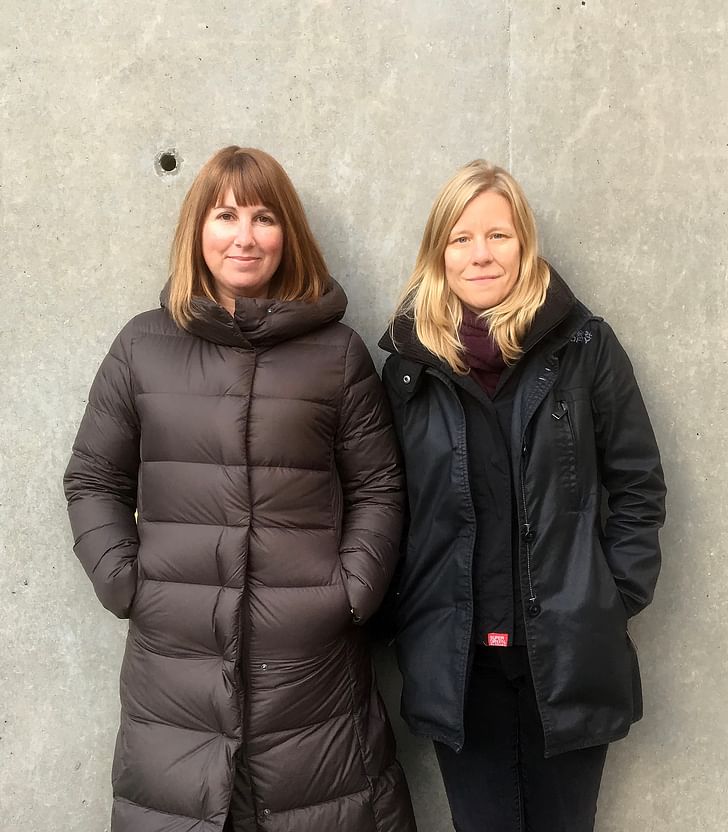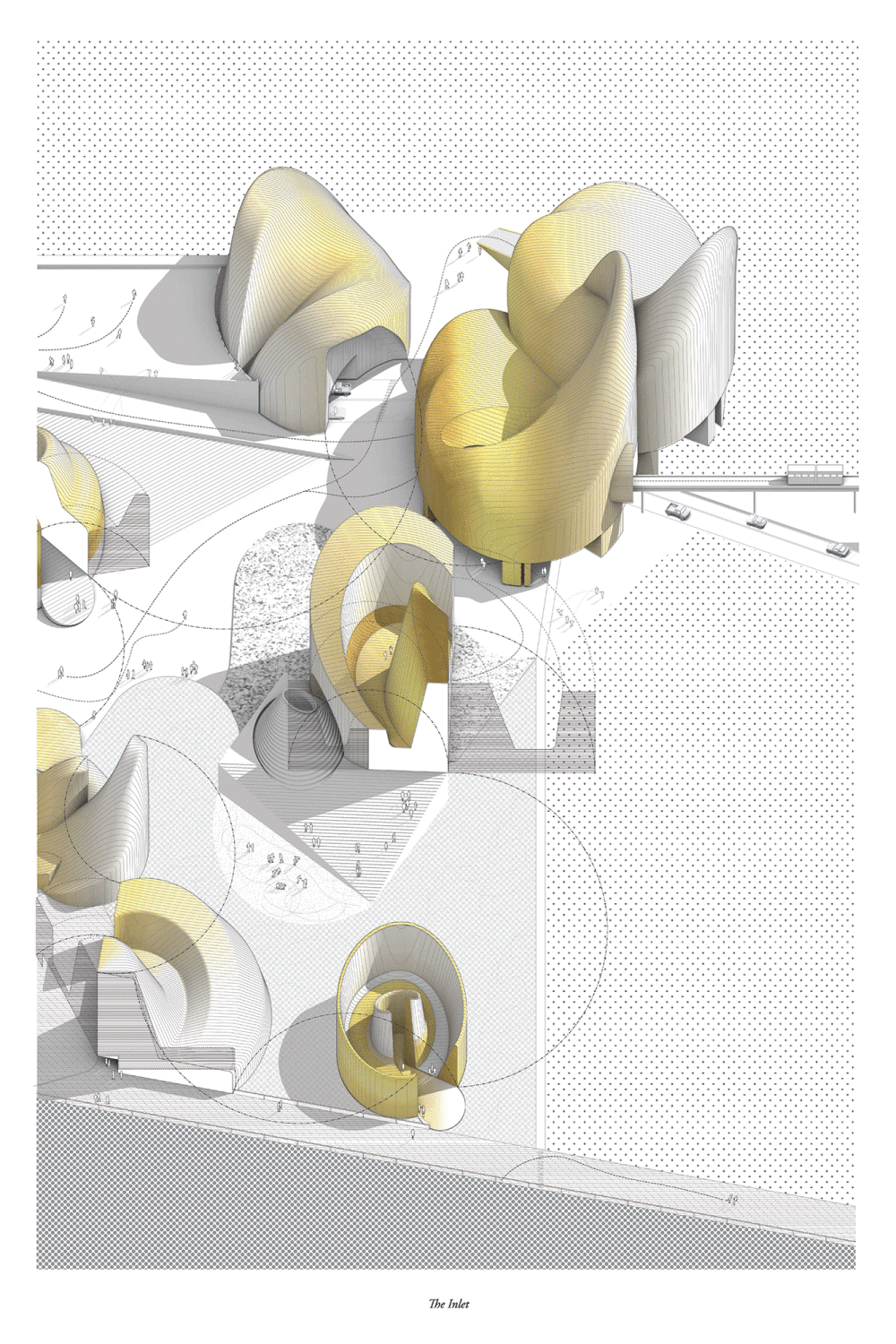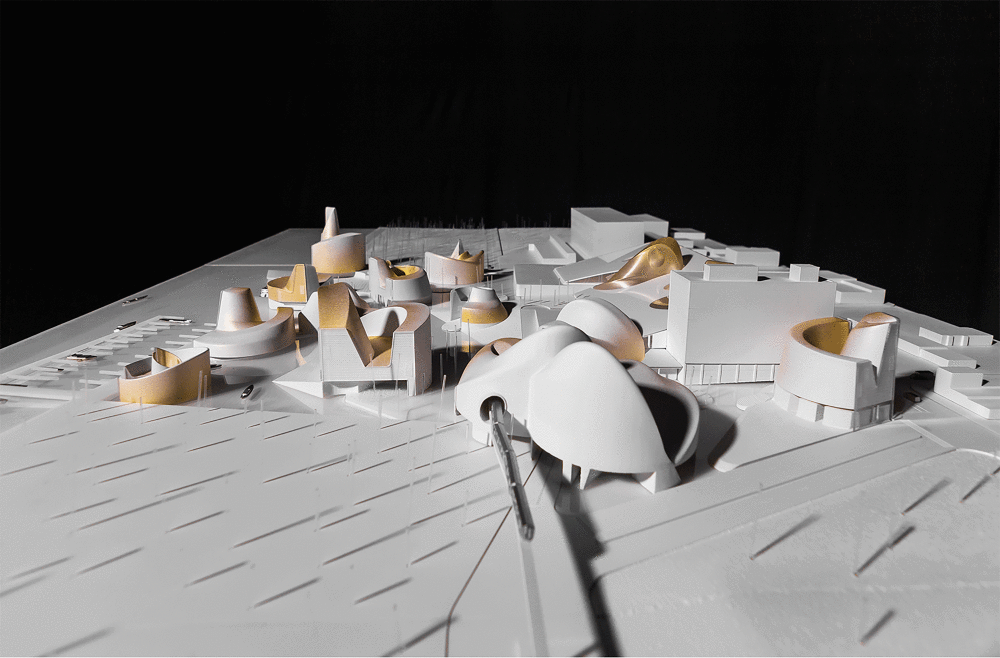

Computational design. Experimentation. Practice. Academia. Kelly Bair and Kristy Balliet of BairBalliet traverse these realms of architecture daily. From their work as educators shaping the future of architectural thinking and discourse to showcasing their skillsets as contemporary architects, the duo use their similarities and differences to open up new opportunities of what is possible. Recently publishing their collaborative curatorial project, Possible Mediums, Kelly and Kristy explore themes of two-dimensional and three-dimensional volumes and the relationship between "inside and outside" perspectives.
For this week's Studio Snapshot, BairBalliet shares their early experiences of starting a practice and how their collaborative efforts allowed them to find "methods and mediums to expand the dialogue" in the profession.
How many people are in your practice?
We are two partners, Kelly and Kristy, based in Chicago and Los Angeles. We currently have three other women on our team. This number can fluctuate with the pace of projects in the office but we have been hovering around four total. For large short-term projects such as the Venice Biennale (2016) and PS1 MoMA (2018) we have assembled larger teams.
Why were you originally motivated to start your own practice?
We first started working together on a curatorial project called Possible Mediums in early 2012. While Possible Mediums was not a design project we recognized a lot of our shared interests in architecture that drew from different perspectives and with varied approaches. Our respective research at that time may have even been seen as opposite one another but as we collaborated, we found ourselves meeting in the middle both geographically and architecturally. Themes such as thresholds that mediate between inside and outside and the oscillation between two-dimensional profiles and three-dimensional volume became a foundation that we continue to build on.
What hurdles have you come across?
There is tension between the world of academia and the world of practice. We are both professors, Kristy at the Southern California Institute of Architecture and Kelly at the University of Illinois at Chicago. It can be a challenge to balance occupying both of those worlds, however exploring their symbiosis or possibly even the intentional conflict between them has been rewarding. They entertain very different audiences and we try to find methods and mediums to expand the dialog between these audiences.
Also, file structure is difficult with the same initials.
Is scaling up a goal or would you like to maintain the size of your practice?
Our goal is to make an impact. We often discuss the best tactics for this between our interest in larger projects and the day to day workings of the office. It’s not clear whether the way a practice could be developed even 10 years ago is applicable or possible in the same way today. Developing an office can be a project in itself, but size has never been a given or a driver as part of those discussions for us.
What are the benefits of having your own practice? And staying small?
By having our own practice we can develop our own values and hone our intentions. Staying small is a part of that for now.
Do you have a favorite project? Completed or in progress.
I think our favorite project is always the one we’re currently working on. In some ways we often look at the lineage of work from the first project for the Venice Biennale, “The Next Port of Call”, to our works in progress. They could almost be conceived as a single project playing out in episodes of various mediums (models that behave like drawings, drawings that act like models, films) at a multitude of scales (urban, building, object).


Can you talk about G.L.O and how you incorporate the process of computational drawings into your designs?
G.L.O. came at a time in the office when we were ready to more clearly define our collaborative practice versus earlier projects that relied more on our own tried and true methods. We were invited by Daniel Cardoso Llasch to contribute a project to the exhibition “Designing the Computational Image/ Imaging Computational Design” that he was curating at the Miller Gallery at Carnegie Mellon University. Knowing the exhibition would primarily consist of two-dimensional printed works we were interested in challenging the notion of image through the design and fabrication of “drawn objects”. The conflation of image and object developed from earlier projects that conflated drawings and models as mentioned above. Each of the three objects we designed for the exhibition were riffs on fairly mundane objects you would find hung on a wall, though not typically on an exhibition gallery wall: a shelf, a plaque, and a tapestry.
At the same time we were using virtual reality drawing environments to conflate real sites and digital modeling environments in the form of a short film, “(Another) Rear Window”. The VR method of drawing was furthered in G.L.O. as we used the environment to draw the source material using a wide bandwidth of control variables. On the low end of the control spectrum this medium offered us gestural characteristics typically associated with analog drawing but often absent from digital drawing, which tends to embrace ultimate precision. Each object was “drawn” from above, around, and even within itself in an effort to expand the canvas beyond the traditional screen. We wanted to challenge the conventional use of VR as merely a viewing device and instead find agency in it as a design tool.
Each object was imbued with a graphic (two-dimensional line or texture), a line (a three-dimensional line in all directions), and an object (a solid or hollow part), hence the G.L.O. We were also both addicted to the Netflix series GLOW (Gorgeous Ladies of Wrestling) at the time so there was definitely some influence there regarding the title.
Congratulations on the completion and publishing the Possible Mediums book! Can you share with us the reason for its creation and what your biggest takeaways were after exploring various design mediums?
Thank you! Possible Mediums developed out of an urgent need to discover, interrogate, and brush up against a set of peers that shared an obsession with a level of precision related to what they were working on. In the process it has become clear that understanding differences in the approach to mediums offers opportunities to be more critical of your own position and the qualities you are seeking. While the project has a collective spirit, one of the biggest takeaways is that defining differences, no matter how subtle, is vital for a designer.
As educators what do you think is the biggest obstacle you see architecture students facing when it comes to understanding computational drawings and its influence in the design process?
Our role as contemporary architects is to challenge the conventions of how software is used; hybridizing software to avoid a singular aesthetic or technique and ultimately carving out new territory for how we perceive, communicate, and represent our work to a broader audience outside of the walls of the academy. Students too often get caught up just trying to “learn” software rather than testing it. The expertise of an architect does not lie in the command of a computational technique, but rather in the approach towards defining space.

Our role as contemporary architects is to challenge the conventions of how software is used; [...] Students too often get caught up just trying to “learn” software rather than testing it. The expertise of an architect does not lie in the command of a computational technique, but rather in the approach towards defining space.

What's the best advice anyone has given you when it comes to your work, practice, etc?
We’ve both been fortunate to work with many great mentors along the way and we try to pay their advice forward to both our students and the office team. One bit of advice we received was to “not go into debt for that project/exhibition even though most have in the past”. We listened to that advice and while it’s required us to work more diligently to find efficient solutions to problems it has also resulted in some formal and material ingenuity that may never have arisen without challenging standard practices in the building/material manufacturing industry.
If you could describe your practice in three words what would they be?
“It’s sufficiently weird”*
Katherine is an LA-based writer and editor. She was Archinect's former Editorial Manager and Advertising Manager from 2018 – January 2024. During her time at Archinect, she's conducted and written 100+ interviews and specialty features with architects, designers, academics, and industry ...
No Comments
Block this user
Are you sure you want to block this user and hide all related comments throughout the site?
Archinect
This is your first comment on Archinect. Your comment will be visible once approved.